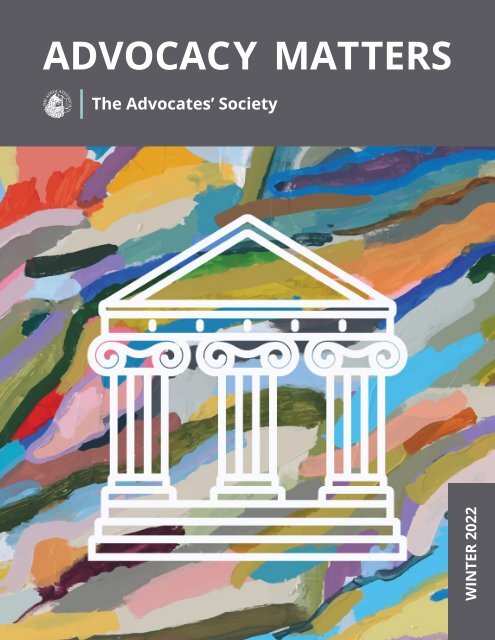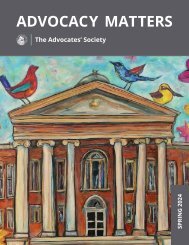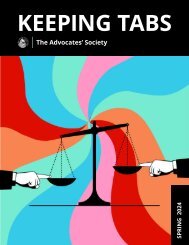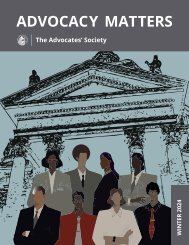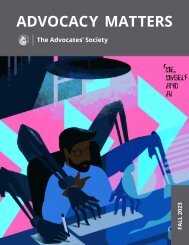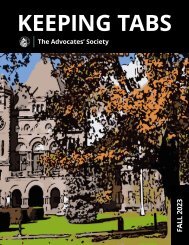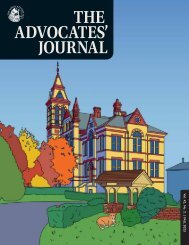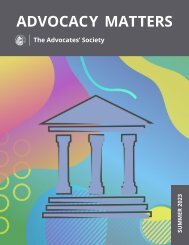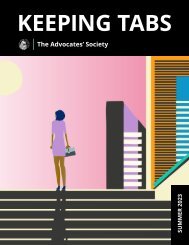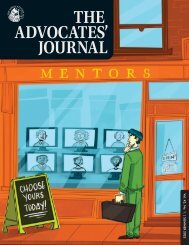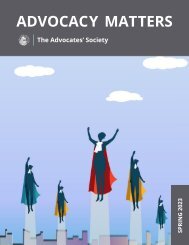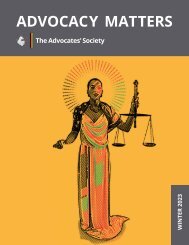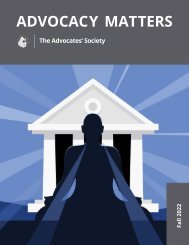Advocacy-Matters-Winter-2022
Keep up to date on what your fellow Society members have to say in Advocacy Matters.
Keep up to date on what your fellow Society members have to say in Advocacy Matters.
You also want an ePaper? Increase the reach of your titles
YUMPU automatically turns print PDFs into web optimized ePapers that Google loves.
ADVOCACY MATTERS<br />
The Advocates’ Society<br />
WINTER <strong>2022</strong>
THE ADVOCATES’ SOCIETY<br />
<strong>2022</strong> END OF TERM<br />
DINNER<br />
Thursday, June 23, <strong>2022</strong><br />
Guest Arrival: 5:30 pm | Dinner: 7:00 pm<br />
Canadian Room at the Royal York Hotel,<br />
100 Front St W, Toronto, ON, M5J 1E3<br />
Black Tie | A member-only event
What the TWEET is this?<br />
When you see this icon, throughout the publication,<br />
click on it to see what members are tweeting about.<br />
CONTENTS<br />
05<br />
06<br />
11<br />
12<br />
14<br />
17<br />
21<br />
Chair Chat<br />
Emily Lawrence, Paliare Roland Rosenberg Rothstein LLP<br />
Catching up with Faisal Mirza:<br />
Addressing systemic racism in<br />
R. v. Morris and R. v. Anderson<br />
Michelle Alton, Workplace Safety & Insurance Appeals Tribunal<br />
Word to the Wise: Mentors at all Stages<br />
Faren Bogach, Construct Legal<br />
How to Mentor: It’s Not About You<br />
Ben Kates, Law Society of Ontario<br />
Panel On Women In Middle Years Of Practice –<br />
Some Advice And Reflections<br />
Ayesha Laldin, Department of Justice<br />
Highlights from Women in Litigation<br />
Compiled by Miranda Spence, Aird & Berlis LLP<br />
Roundtable: Building Your Book of Business<br />
Using Alternative Fee Structures<br />
Compiled by Megan Keenberg, C.S., Van Kralingen & Keenberg LLP<br />
Editor: Tamara Ramsey, Dale & Lessmann LLP<br />
The opinions expressed by individual authors are their own and do not necessarily reflect the policies of The Advocates’ Society.<br />
<strong>Advocacy</strong> <strong>Matters</strong> Editorial Team: Michelle Alton, Tribunal General Counsel, Daniel Baum, Langlois Avocats, Megan Keenberg, Van Kralingen &<br />
Keenberg LLP, Ayesha Laldin, Department of Justice Canada, Ontario Regional Office, Zoe Oxaal, Department of Justice, Canada, Civil Litigation Section,<br />
Miranda Spence, Aird & Berlis LLP, Christine Vanderschoot, Vanderschoot Family Law<br />
3
CHOOSE FROM CANADA’S TOP<br />
MEDIATORS AND ARBITRATORS<br />
Members of the Canadian Academy of Distinguished Neutrals<br />
Ronald M. Dash<br />
Ron has over 45 years of<br />
experience resolving a wide variety<br />
of commercial, employment,<br />
insurance, construction and real<br />
estate matters as a mediator,<br />
arbitrator, Master of the Superior<br />
Court of Justice and litigator. He<br />
has a well deserved reputation for<br />
getting quickly to the heart of a<br />
dispute.<br />
W.A. Derry Millar<br />
Derry has over 45 years of legal and<br />
neutral experience. His expertise<br />
includes commercial, aviation,<br />
estates, environmental, insurance,<br />
product liability and real estate<br />
matters. He was elected as a Fellow<br />
of the American College of Trial<br />
Lawyers, is also a Fellow of the<br />
Chartered Institute of Arbitrators.<br />
Derry is a recipient of the Law<br />
Society Medal and the Catzman<br />
Award for Professionalism and<br />
Civility.<br />
2021-22<br />
2021-22<br />
READERS’<br />
CHOICE<br />
ADR & MEDIATION CHAMBERS<br />
416.362.8555 • 1.800.856.5154 • booking@adr.ca • adrchambers.com
CHAIR CHAT<br />
Chair Chat<br />
Emily Lawrence,<br />
Paliare Roland Rosenberg Rothstein LLP<br />
Welcome to <strong>2022</strong>!<br />
I don’t set New Year’s resolutions. But I do try to spend some time reflecting on the past year and<br />
thinking about the year ahead. In 2021, I tried to keep my personal and professional objectives<br />
small and concrete. 2021, for me, was about taking it day by day (pandemic wave by pandemic<br />
wave), finding ways to be of service, and being compassionate to my family, colleagues, peers, clients,<br />
and myself. Despite another worrisome wave of the pandemic, I am thinking bigger this winter.<br />
I am excited and optimistic that we will make a shift back to in-office work life and in-person<br />
gatherings this year. I can’t wait to share lunch with my colleagues, grab coffee with my mentees,<br />
and chat with old friends in the robing room or the TAS event space. It will be a transition, and<br />
perhaps a rocky one, but I am more than ready.<br />
The pandemic propelled forward how we practise law using virtual tools – a small silver lining –<br />
and required all of us to find new ways to deliver excellent service to our clients. Collectively, we<br />
pivoted to virtual practice because we had to, but we now have an opportunity to assess what<br />
aspects of virtual practice may serve us long-term. It’s also a chance to consider the business of<br />
lawyering post-pandemic. To get you started, this issue features a thoughtful roundtable on thinking<br />
outside the box about fee structures for clients. The pandemic has also laid bare inequities in<br />
our justice system; I encourage you to read Michelle Alton’s interview of Faisal Mirza on the use of<br />
sentencing reports in criminal proceedings and parole hearings.<br />
Throughout the last two years, TAS has been a source of education, insight, and socialization for<br />
me. I am proud of the work of the 10+ Standing Committee, and TAS as a whole, to continue to deliver<br />
timely and insightful programming that has brought together advocates from across the country.<br />
This <strong>Winter</strong> <strong>2022</strong> issue highlights some of those events, including an excellent program in which<br />
junior lawyers spoke candidly about what they really want from their mentoring relationships, and a<br />
debrief from one of TAS’s signature events, the Women in Litigation Symposium (Ontario).<br />
Wishing you a warm and safe beginning of the year.<br />
5
THE JUSTICE SYSTEM<br />
Catching up with Faisal<br />
Mirza: Addressing systemic<br />
racism in R. v. Morris and<br />
R. v. Anderson<br />
Michelle Alton,<br />
Workplace Safety & Insurance Appeals Tribunal<br />
A previous article in <strong>Advocacy</strong> <strong>Matters</strong> highlighted the Ontario Sentencing and Parole Project (SPP)<br />
along with one of its co-founders, Faisal Mirza. Recently, in R. v. Morris, the Court of Appeal for<br />
Ontario considered one of the reports generated from the SPP. A few months before Morris was<br />
released, the Nova Scotia Court of Appeal considered a similar type of report, Impact of Race and<br />
Culture Assessments (IRCA), in R. v. Anderson. In this article, we talk to Faisal about the Morris and<br />
Anderson decisions, as well as next steps as the justice system strives to address systemic racism.<br />
In R. v. Anderson, 2021 NSCA 62, the Nova Scotia Court of Appeal considered IRCAs, noting its re-<br />
6
sponsibility as an appellate court to equip judges<br />
who are tasked with sentencing offenders of<br />
African descent with the necessary tools to craft<br />
fit sentences.<br />
Mr. Anderson, an African Nova Scotian, had<br />
received a conditional sentence of 2 years less a<br />
day, followed by a probationary term of 2 years,<br />
for firearm offences. At sentencing, the Crown<br />
had sought a federal penitentiary term in the<br />
range of 2 to 3 years. At the appeal, the Crown<br />
changed its position and accepted that the conditional<br />
sentence was a fit and proportionate<br />
sentence. With the support of the intervenors,<br />
the Crown asked for guidance in applying the<br />
principles of sentencing to offenders who are of<br />
African descent.<br />
The Court of Appeal acknowledged in its decision<br />
that certain groups in Canadian society are<br />
disproportionality incarcerated, notably Indigenous<br />
offenders and Black offenders. The Court<br />
also strongly endorsed the use of IRCAs in sentencing<br />
African Nova Scotian offenders.<br />
In R. v. Morris, 2021 ONCA 680, the issue being<br />
appealed was the sentence imposed for Mr.<br />
Morris, a black man who had been sentenced<br />
to 15 months plus 18 months’ probation for<br />
gun-related charges, including possessing a<br />
loaded prohibited/restricted handgun and carrying<br />
a concealed weapon.<br />
On appeal, the Crown argued that the sentence<br />
was manifestly unfit and proposed a<br />
sentence of 3 years. In particular, the Crown argued<br />
that the trial judge had allowed his consideration<br />
of the impact of overt and institutional<br />
racism on Mr. Morris to overwhelm all other<br />
considerations relevant to fashioning a sentence.<br />
Several intervenors participated in the<br />
appeal and, in general, the intervenors and Mr.<br />
Morris argued that the trial judge had properly<br />
admitted and considered evidence of overt and<br />
institutional systemic anti-Black racism and its<br />
negative impact on Mr. Morris.<br />
The Court of Appeal allowed the appeal and varied<br />
the sentence to 2 years less a day, followed<br />
by probation on the terms imposed by the trial<br />
judge. The sentence was permanently stayed.<br />
In reaching this decision, the unanimous fivejudge<br />
panel of the Court of Appeal acknowledged<br />
that both overt and systemic anti-Black<br />
racism is a reality in Canadian society. The<br />
Court set out general principles to guide sentencing.<br />
The Court was also complimentary of<br />
a report prepared as part of the SPP which described<br />
Mr. Morris’s history and circumstances.<br />
The Court noted that these types of reports can<br />
be of great assistance to a sentencing judge and<br />
stated that they hope that the preparation of<br />
these reports will be adequately funded and<br />
will become a common feature of sentencing in<br />
appropriate cases. 1<br />
Question: Faisal, as a co-founder of the SPP,<br />
and as counsel for Mr. Morris in his appeal,<br />
what are your thoughts about the Court of<br />
Appeal’s decision in Morris?<br />
Answer: It’s a legal breakthrough in the struggle<br />
against racial inequality in sentencing and a<br />
7
ecognition that all members of the justice system<br />
should learn about the detrimental impact<br />
of racism on essential parts of life, coupled with<br />
a clear direction to sentencing judges to obtain<br />
and consider this critical information when assessing<br />
proportionality. It’s a moral and legal<br />
imperative to address racism in a system in<br />
which Black people are over-represented and<br />
mistreated. This will help judges to make better-informed<br />
sentencing decisions.<br />
Question: You represented one of the intervenors,<br />
the Criminal Lawyers’ Association,<br />
in the Anderson appeal. How does the Morris<br />
decision compare to the Anderson decision?<br />
Answer: The decision in Anderson thoroughly<br />
recognizes that the distinct experiences of Black<br />
people must be better reflected in the sentencing<br />
process and determination of outcomes. The<br />
decision is fresh appellate guidance to bring the<br />
law into harmony with a modern understanding<br />
of the impact of racism so that judges can fairly<br />
assess the context in which offences occur and<br />
the degree of responsibility of certain offenders.<br />
The ruling recognizes that a superior understanding<br />
of an individual’s circumstances is necessary<br />
to advance equal treatment.<br />
The Morris decision recognizes that anti-Black<br />
racism must be addressed, that sentencing is<br />
better informed by an understanding of its detrimental<br />
impact, and that Enhanced Pre-Sentence<br />
Reports (or IRCAs, referring to their use<br />
in Anderson) are an important tool to improve<br />
outcomes. The Court of Appeal states that they<br />
can be of great assistance to a sentencing judge<br />
to assess the moral blameworthiness of an individual.<br />
At the trial and the appeal, the Courts<br />
found that this information supported the imposition<br />
of a far lesser sentence than sought<br />
by the prosecution. Even though the Court of<br />
Appeal increased the sentence marginally, they<br />
encouraged judges to give serious consideration<br />
to a conditional sentence to be served in<br />
the community in appropriate cases. The Court<br />
commented that hopefully these types of reports<br />
will be funded and become a common<br />
feature of sentencing.<br />
I hope so too. The SPP team will continue to<br />
do everything we can to prepare thorough and<br />
objective reports that educate. Our team is composed<br />
of clinical social workers, scholars, and<br />
lawyers who have considerable experience. We<br />
are continuing to grow and improve every day<br />
with the support of the community and our partners.<br />
Inadequate pre-sentence reports and a lack<br />
of understanding about the impact of racism is<br />
a source of inequality in criminal law. We must<br />
continue to find solutions to these problems.<br />
Question: In August 2021, the federal government<br />
announced that it would be investing<br />
in measures to address systemic racism<br />
in the criminal justice system, including<br />
providing funding of $6.64 million over five<br />
years, followed by $1.6 million in ongoing<br />
funding, to support the implementation of<br />
IRCAs in all provinces and territories. IRCAs<br />
and the SPP are one part of the important<br />
work that must be done to understand and<br />
address systemic racism issues in the justice<br />
system, particularly in the criminal context.<br />
What do you think are the necessary next<br />
steps? Where do we go from here?<br />
Answer: There is a lot more to learn about racial<br />
injustice. In my view, knowledge about the<br />
sources and impact of inequality improves the<br />
competency of lawyers and judges. It strengthens<br />
the quality of advocacy and better informs<br />
decisions. I will continue to support the progression<br />
of core law school education, research, and<br />
professional development in this area.<br />
Note<br />
1. The Court of Appeal also noted that with more experience in<br />
preparing these reports, and additional guidance from the courts,<br />
the reports will improve, including authors appreciating the need to<br />
present an objective assessment while avoiding the appearance of<br />
taking on the role of advocate for the offender.<br />
8
The Honourable<br />
Rosalie Silberman Abella –<br />
A Life of Firsts<br />
May 12 & 13, <strong>2022</strong><br />
Ottawa<br />
Online and In-person<br />
The Advocates’ Society is proud to be supporting this special event celebrating<br />
former Supreme Court Justice, The Hon. Rosalie Silberman Abella. Our Past<br />
President, Guy J. Pratte, will be acting as Master of Ceremonies for the<br />
Gala Dinner, and TAS will deliver a panel at the conference, entitled Justice<br />
Abella & Women in the Legal Profession. This session will explore Justice<br />
Abella’s trailblazing career and its specific significance for women in the legal<br />
profession and features TAS President Deborah E. Palter, Thornton Grout<br />
Finnigan LLP as Panel Chair and speakers The Hon. Justice Andromache<br />
Karakatsanis, Supreme Court of Canada, Sana Halwani, Lenczner Slaght<br />
LLP, The Hon. Justice Freda Steel, Manitoba Court of Appeal, Rosalie Jukier,<br />
Professor and Associate Dean, Faculty of Law, McGill University, Linda<br />
Rothstein, LSM, Paliare Roland Rosenberg Rothstein LLP, and Shantona<br />
Chaudhury, Pape Chaudhury LLP.<br />
Full conference details are available here.
MENTORING<br />
Word to the Wise:<br />
Mentors at all Stages<br />
Faren Bogach, Construct Legal<br />
The team was gearing up for a long hearing. We had been working for weeks to get everything<br />
ready. I had been on the file from the beginning, and it was going to be the biggest hearing that I<br />
had ever participated in. When the time came to decide who would examine and cross-examine<br />
the witnesses, imposter syndrome kicked into high gear for me. I was about to tell the more senior<br />
lawyer that they should take the lead on all the major witnesses.<br />
I guess my fears were obvious. Someone pulled me aside and said: “You know the file best. You<br />
have worked so hard on it over the years, and you can’t stop now. You need to examine those<br />
witnesses. You can do it.”<br />
I needed to hear that message. To have someone talk over the doubt in my mind and encourage<br />
me to do something that I was ready and able to do. And like me, others need that the vote of<br />
confidence and trust in the tougher times; the push to reach beyond a comfort zone.<br />
Finally, the person who gave me that important message was a more junior lawyer on the file.<br />
There seems to be an expectation that a mentor is someone more senior or more experienced,<br />
but that isn’t always the case. Especially in these strange times when we are more isolated from<br />
others, it is necessary look to everyone around us for advice and encouragement.<br />
11
EVENT REPORT<br />
How to Mentor:<br />
It’s Not About You<br />
Ben Kates, Law Society of Ontario<br />
The opinions expressed are those of the author.<br />
They do not reflect the opinions or views of the Law Society of Ontario.<br />
This fall, the 10+ Standing Committee’s Mentorship Working Group made a candid admission:<br />
we don’t have a clue what it’s like to practise as a junior lawyer during a pandemic and we have<br />
a feeling we are somewhat ill-equipped to mentor them through it. So, we decided to go to the<br />
source for advice.<br />
12
• Build trust: The onus is on the mentor<br />
to create the time and space required to<br />
build a relationship that is authentic and<br />
comfortable. This process can take time.<br />
New lawyers are dealing with the self-consciousness<br />
that comes with stepping into<br />
a new setting. It can be intimidating for a<br />
mentee to ask for a meeting or be transparent<br />
about their needs. Mentors should<br />
be sensitive to the mentee’s concern that<br />
their candour may come back to hurt them<br />
down the line and also be transparent<br />
about any limits to the confidentiality of<br />
their discussions.<br />
On November 9, 2021, I acted as moderator<br />
of our fall event, “It’s Not About You”. The concept<br />
of the panel discussion was to turn the<br />
tables and hear from junior lawyers directly<br />
about what it’s like to practice in this day and<br />
age, and what they look for in a mentor. Our<br />
panel was well-suited to speak to the topic, with<br />
each member having either started or transitioned<br />
their practice during the pandemic.<br />
Khrystina McMillan (Mathers McHenry & Co) lateralled<br />
from one Toronto-based litigation firm<br />
to another; Zachary Al-Khatib (Liberty Law LLC)<br />
left a Toronto firm to practise criminal law in<br />
his home city of Edmonton, and Alana Robert<br />
(McCarthy Tétrault LLP) graduated from articling<br />
student to litigation associate, all while working<br />
from home.<br />
Thanks to Khrystina, Zachary, and Alana, here<br />
are some insights on how to approach mentorship<br />
in the age of remote work:<br />
• Give feedback: More feedback is always<br />
better! Early missteps can calcify into bad<br />
habits if you wait too long to course correct.<br />
Take the time to explain not only what could<br />
have been done differently, but why. A new<br />
lawyer might not appreciate the full context<br />
that dictates how work is done—for example,<br />
things like business considerations. Frequent<br />
feedback also fosters approachability.<br />
In a genuine relationship, mentees will<br />
feel more comfortable encroaching on your<br />
time to hear how they can improve.<br />
• Have empathy: Remote work has meant<br />
that work and home have melded together,<br />
making the line between work and personal<br />
hours indistinguishable. At the same<br />
time, new lawyers are learning to practise<br />
in literal and figurative isolation. Empathetic<br />
check-ins from mentors can help. While<br />
regular online check-ins were a great tool<br />
back in April 2020, Zoom fatigue came hard<br />
and fast. Be creative and think about different<br />
ways to reach out to your colleagues in<br />
a safe way, like meeting for a walk or coffee<br />
on a bench. Try not to think of mentorship<br />
as a task or a chore, but as a part of the job<br />
you can both look forward to.<br />
13
EVENT REPORT<br />
Panel On Women In Middle<br />
Years Of Practice – Some<br />
Advice And Reflections<br />
Ayesha Laldin, Department of Justice<br />
On December 10, 2021, the Women in Law Working Group of the 10+ Standing Committee hosted<br />
“Juggle, Juggle, Toil and Trouble: Inspirations for Keeping Women in Practice”, a roundtable featuring Lianne<br />
B. Furlong (Aviva Trial Lawyers), Dominique T. Hussey (Bennett Jones LLP), and Maureen Killoran,<br />
QC (Osler, Hoskin & Harcourt LLP), and moderated by Ewa Krajewska now of Henein Hutchinson LLP.<br />
It was a lively discussion about the particular challenges many women face in the middle years of<br />
their practices, due to increasing responsibilities and pressures from multiple fronts of their lives.<br />
The speakers shared their stories about the challenges they experienced in mid-years of practice<br />
and strategies on how to deal with the urge to leave, if it strikes. Lianne Furlong spoke<br />
14
about her transition from private practice to<br />
in-house after her maternity leave, that was<br />
prompted by the lack of accommodation at<br />
the firm where she practised. After several<br />
years at Aviva and a second maternity leave,<br />
she has since accepted several promotions.<br />
Now she prioritizes herself. According to Maureen<br />
Killoran, every year can be hard, and it is<br />
about what you can and cannot handle. It is<br />
not unusual to have times when you feel you<br />
are failing everyone all the time, and when that<br />
happens, it requires a readjustment and a focus<br />
away from perfection. Dominique Hussey<br />
spoke about her experiences, shared by many<br />
women at the ten-year mark. This is often a<br />
time when women practising in firms have just<br />
been admitted to the partnership and are also<br />
raising a young family. Upon returning from<br />
maternity leave, she worked hard to build up a<br />
practice group and take leadership roles, while<br />
also building advocacy skills. It can be a challenging<br />
time because one is senior enough to<br />
be making strategic decisions for clients, but<br />
junior enough to still be tasked with ”heavy lifting”<br />
duties like drafting.<br />
Looking back, the panelists had some reflections<br />
on what they know now that they wished<br />
they knew in their middle years of practice.<br />
Lianne Furlong talked about the importance<br />
of women keeping the imposter syndrome in<br />
check by reminding themselves that they are<br />
highly educated, competent and know as much<br />
as the person next to them. Maureen Killoran<br />
wanted women to know that working does not<br />
harm children; it enhances their ability to do<br />
many things. Women should also not look to<br />
their children for approval of their career choices.<br />
It’s your career, not theirs. Dominique Hussey<br />
urged that we should try to shut down the<br />
assumptions that flow from a woman’s reproductive<br />
decisions. For example, the assumption<br />
that all new mothers are busy and unavailable,<br />
or women with no children are available and<br />
can take on added burdens needs to be rejected.<br />
Women should be much clearer about what<br />
they want to take on.<br />
15
Wednesday, April 27, <strong>2022</strong> | 9:00 am - 4:00 pm (ET)<br />
Hybrid Conference: Live Online and In-Person at<br />
The Advocates’ Society’s Education Centre,<br />
250 Yonge Street, Suite 2700, Toronto<br />
This practical program features the latest developments,<br />
strategies and tools for adapting and succeeding in your<br />
evolving litigation practice.<br />
If you are a civil litigator serious about<br />
advocacy, this is one program you<br />
cannot afford to miss! With in-person<br />
and virtual attendance options<br />
available, no matter how you<br />
choose to join us, you will<br />
take part in a dynamic and<br />
engaging day of learning.<br />
REGISTER
EVENT REPORT<br />
Highlights from<br />
Women in Litigation<br />
“Allyship and other themes from the TAS Women in Litigation Symposium”<br />
Compiled by Miranda Spence, Aird & Berlis LLP<br />
The theme of the 2021 Women in Litigation Symposium (Ontario) was, “Allies in an Era of Change.”<br />
As always, the conference featured knowledgeable and engaging speakers addressing timely topics.<br />
Attendees were treated to candid explorations of panellists’ experiences and heard about<br />
ways we can stand up as effective allies.<br />
Allyship through Leading by Example - Cynthia Spry, Babin Bessner Spry<br />
One of my favourite panels at this year’s Symposium was View from the Bench, with Justices Thorburn,<br />
Vella and Waddilove. All were excellent, and my reaction to Justice Waddilove’s story of her<br />
path to the bench was visceral.<br />
Her Honour grew up on a First Nations reserve outside London. It had no dedicated school or<br />
clean water. This remains the case today. The teachers she did have told her that her people were<br />
savages, and better suited to manual labour. When she finally joined a non-reserve school, she<br />
was three academic years behind her non-reserve peers. She sought out supportive teachers, and<br />
17
Cynthia Spry, Babin Bessner Spry<br />
worked very hard to catch up. She succeeded<br />
and thrived. In 2019, she became<br />
a justice of the Ontario Court of Justice.<br />
Her Honour talked about how — not<br />
so long ago — First Nations people could<br />
not vote, could not leave the community<br />
without permission from an Indian Agent,<br />
could not gather in groups of more than<br />
three without being considered an “uprising”,<br />
and could not go to university without<br />
losing their Indian status.<br />
Against this background, Justice Waddilove<br />
said that creativity, change and<br />
courage are required to move forward.<br />
She counseled her listeners to take care<br />
of ourselves, physically and mentally,<br />
and seek out people who support us,<br />
who do work that is important to us,<br />
with whom we have a meeting of the<br />
minds. She encouraged us to lead by<br />
example; there are generations coming<br />
up behind us who are looking to us to<br />
help and support them. We must walk<br />
with pride and strength and confidence<br />
in who we are.<br />
Justice Waddilove’s history, and the<br />
too-recent history of Indigenous people<br />
generally, emphasized anew for me how<br />
important it is that we celebrate and promote<br />
the increasing diversity on the bench<br />
and in other positions of power, and also<br />
recognize how far we have yet to go.<br />
Ayesha Laldin, Department of Justice<br />
Allyship through Diversity on the Bench -<br />
Ayesha Laldin, Department of Justice<br />
This year’s View from the Bench panel featured<br />
a lively discussion on the importance<br />
of diversity in judicial appointments. Judges<br />
bring unique perspectives and life experiences<br />
to their “judicial voice”, Justice Vella<br />
explained. This voice is reflected in the<br />
way they articulate reasons for judgment<br />
and in their approach to identifying issues<br />
and reaching a resolution. The way a judge<br />
18
uns her courtroom has a critical impact on<br />
marginalized parties feeling respected and<br />
heard. It fosters greater confidence in the<br />
justice system. Justice Waddilove echoed<br />
that judicial diversity fosters a commitment<br />
to listen with an open mind, as the criminal<br />
justice system means different things<br />
to many different people. It requires a<br />
commitment to challenge one’s own belief<br />
systems and learn from under-represented<br />
communities. For Justice Vella, this in<br />
practice means encouraging reconciliation<br />
through use of court processes like pre-trial<br />
or case conferences.<br />
Allyship through Mentoring -<br />
Miranda Spence, Aird & Berlis LLP<br />
One of the highlights of this year’s conference<br />
was the mentoring roundtable sessions,<br />
where attendees were able to (virtually)<br />
discuss their thoughts and reactions to<br />
the themes of the day and, along the way,<br />
share their own personal experiences.<br />
We have repeatedly heard that one of<br />
the many losses of the pandemic has been<br />
the informal mentoring that happens simply<br />
from being in proximity to one another.<br />
The roundtable discussions reminded<br />
me that mentoring is about more than an<br />
individuals’ personal growth and imparting<br />
wisdom from one generation to the<br />
next. Sharing stories among peers whose<br />
experiences differ from our own is a form<br />
of allyship and can provide the type of support<br />
that may be lacking in formal policies<br />
or structures. Indeed, in her Advocates’<br />
Journal article, “Litigating through motherhood:<br />
Can we talk?”, Lisa Brownstone<br />
referred to “true, honest conversations<br />
about our experiences” as a “hack” for litigator<br />
moms. One of the best ways to find<br />
common ground across diverse perspectives<br />
is to simply keep talking – and listening<br />
– to one another.<br />
Miranda Spence, Aird & Berlis LLP<br />
19
Building Block Series:<br />
Motions <strong>Advocacy</strong><br />
Live Online<br />
Motions are a key tool in an advocates’ arsenal. They can streamline proceedings or help<br />
settle disputes – but only if you know when and how to deploy them effectively.<br />
After rave reviews, the Building Block Series returns in <strong>2022</strong> with a comprehensive focus on<br />
motions advocacy. Seasoned litigators and judges will take you through an in-depth analysis<br />
of best practices, techniques and strategies for each stage of the motion process. Discover<br />
when and how to prepare for, draft materials and conduct an effective motion, and receive<br />
valuable tips for avoiding common traps.<br />
Block 1:<br />
Theory, Preparation, and Building<br />
the Record (Plenary Session)<br />
April 5, <strong>2022</strong><br />
1:00 pm – 4:00 pm<br />
Block 2:<br />
Effective Oral and Written Motions<br />
<strong>Advocacy</strong> (Plenary Session)<br />
May 3, <strong>2022</strong><br />
1:00 pm – 4:00 pm<br />
Block 3:<br />
Conducting an Effective Motion<br />
(Skills Workshop)<br />
June 21, <strong>2022</strong><br />
1:00 pm – 4:30 pm<br />
To learn more or register click here
ROUNDTABLE<br />
Roundtable: Building Your<br />
Book of Business Using<br />
Alternative Fee Structures<br />
Compiled by Megan Keenberg, C.S.,<br />
Van Kralingen & Keenberg LLP<br />
We all know that building your book of business is the key to success in law, but we don’t get a lot<br />
of practical insight into exactly how to do it. One way to stand out from the crowd and attract business<br />
is to get creative around fee structures for clients. I spoke with three leading practitioners<br />
about how fees might be structured to attract and maintain business:<br />
Erin Durant, Founder of Durant Barristers, a boutique firm based in Ontario specializing in disputes,<br />
investigations, and sports law.<br />
Annie Lespérance, Associate Investment Manager & Legal Counsel, and Head of Latin America<br />
Group at Omni Bridgeway, a global litigation funder.<br />
Justin Nasseri, Co-Founding Partner of Ross Nasseri LLP, a litigation boutique in Toronto specializing<br />
in civil and regulatory disputes.<br />
21
How can dispute funding help build your book<br />
of business?<br />
Erin Durant, Durant Barristers<br />
Annie Lespérance, Omni Bridgeway<br />
Annie Lespérance: There are several ways litigators<br />
can leverage dispute funding to help<br />
generate more business and grow their practices.<br />
First, funding allows litigators to take on<br />
a broader range of cases, including meritorious<br />
and potentially lucrative cases from clients<br />
who may not have the capital to afford a firm’s<br />
hourly fees. A law firm may not be prepared to<br />
accept the risk of litigating a matter on a full<br />
contingency-basis to accommodate an impecunious<br />
client. With non-recourse funding, however,<br />
counsel’s fees are paid by the funder, and<br />
the funder is only paid if the claim succeeds.<br />
Second, well-capitalized clients may also<br />
hesitate to launch litigation, even with strong<br />
claims, preferring to use their capital for profit-generating<br />
projects instead of legal fees.<br />
Dispute funders help solve these problems by<br />
taking on the costs of litigation, thus removing<br />
them from the balance sheet and freeing<br />
up capital for the client to pursue other business<br />
priorities.<br />
Additionally, funders can be sources of referrals.<br />
Funders are routinely contacted by clients<br />
with significant claims even before they<br />
have representation. A good relationship with<br />
a funder may translate into a call to introduce<br />
you to a potential client. Finally, funders hire<br />
lawyers, too. As part of the due diligence process<br />
before we invest in a case, we often engage<br />
counsel to provide an independent opinion on<br />
the merits to help guide our funding decisions.<br />
What are some alternatives to the classic full<br />
contingency retainer that can assist law firms<br />
in maintaining revenues while taking on performance-based<br />
mandates?<br />
Justin Nasseri, Ross Nasseri LLP<br />
AL: From a dispute funding perspective, I see<br />
two relevant financial models. A firm may be<br />
prepared to take on a case with a strong chance<br />
of success on full contingency, but the case may<br />
22
equire years of work without payment. A hybrid<br />
scenario can be created whereby a portion<br />
of the case budget is paid at regular intervals<br />
by a funder. The rest can be carried by the firm<br />
on a partial contingency to be paid in the event<br />
of a successful settlement or judgment. In this<br />
way, the firm is able to share in the upside of a<br />
substantial recovery while maintaining a steady<br />
stream of income throughout the lifespan of a<br />
case. The percentage of risk allocation under a<br />
hybrid scenario will be a function of the lawyer’s<br />
and funder’s preference.<br />
Law firms can also bundle multiple contingency-based<br />
claims into a portfolio. By financing<br />
several cases at once, the funder<br />
is able to increase the amount of capital it<br />
can provide. And as the funder recovers its<br />
agreed-upon return, the firm can reap the<br />
rewards from the resolution of the remaining<br />
matters in the portfolio. For the law firm,<br />
a portfolio approach can result in substantial<br />
benefits. Cases that may not have provided a<br />
return on investment for several years now<br />
generate immediate income. Legal finance<br />
may be used to fund operational expenses,<br />
expand a practice, and hire associates.<br />
Some entrepreneurial lawyers have used<br />
this model to help finance start-up and operational<br />
costs for their own boutique firms.<br />
What are the pros and cons of fixed or flat fee<br />
structures?<br />
Erin Durant: I find that there are more pros than<br />
cons. For a new firm like ours, the fixed and flat<br />
fee files have given us some cash-flow predictability.<br />
Individual clients and smaller businesses<br />
also seem to like them as they can appropriately<br />
budget their spend on legal services. The theoretical<br />
con is that you end up spending more<br />
time on the file and haven’t budgeted properly<br />
upfront, but we deal with that by being careful<br />
about the scope description and having an opportunity<br />
to alter the fixed fee if something unexpected<br />
arises on the file.<br />
How do you calculate your flat fees?<br />
Justin Nasseri: My budgeting is based on a<br />
number of factors including data from comparable<br />
cases (what I budgeted and what the actual<br />
fees ended up being) and judgment calls<br />
based on the complexity of the case. I start by<br />
dividing the case into key phases e.g. pleading,<br />
productions, etc. and then subdivide each<br />
phase into steps representing the work involved<br />
in each phase. For each phase and step, I assign<br />
a value. Once the budget is set, I will honour it<br />
and bill in increments; but the budget for future<br />
steps can be revisited and revised if there are<br />
unforeseen complications or issues that arise.<br />
Everything is done incrementally to reflect the<br />
dynamic and somewhat unpredictable nature<br />
of civil and commercial litigation.<br />
Do you include premiums or success fees on<br />
your fixed fee or capped arrangements?<br />
JN: Yes, sometimes I do, particularly in instances<br />
where because of factors such as reasonable<br />
opposing counsel or the existence of settled,<br />
black letter law on the issue in dispute, I think<br />
that an early resolution can be leveraged that<br />
avoids the enormous cost of litigation and fulfills<br />
the client’s goals.<br />
Could you describe a subscription retainer and<br />
tell us what kinds of clients are open to this<br />
kind of billing?<br />
ED: We have some clients who pay us a flat fee<br />
every month. We use an online billing platform<br />
to automatically handle the invoicing and payments.<br />
The subscription service has been adopted<br />
by small businesses and associations that<br />
require regular advice (typically on employment<br />
matters or risk management). The subscription<br />
model has also resulted in disaster avoidance.<br />
The clients are less reluctant to reach out to us<br />
proactively as they know they are paying us<br />
every month to be there for them when they<br />
23
need us. The hope is that we will have far fewer<br />
messes to clean up for clients if they are encouraged<br />
to reach out to us early and often.<br />
Do you find that alternative fee structures result<br />
in greater or lower revenues for your firm<br />
than the billable hour?<br />
JN: I think the answer to this will vary greatly<br />
depending on the nature of the law firm, the<br />
files, and the quality and size of data that they<br />
are relying on. In my experience, in a boutique<br />
setting, it’s shaken out to be about the same;<br />
but that’s because we are very efficient, our<br />
associates are not driven by an ‘hours first’<br />
mentality, and our budgeting is based on data<br />
from a lot of cases where we have billed by the<br />
hour but we feel good about the time spent<br />
and the results achieved.<br />
Are collectability rates different for alternative<br />
fee structures?<br />
JN: Not in my experience. When I am billing by the<br />
hour, I am usually sending accounts every month<br />
or two and if my retainer hasn’t been topped up,<br />
I am asking to be paid promptly. Since most of<br />
the AFAs I have ever used have been fixed-fee/<br />
block billing arrangements that are broken into<br />
phases of the litigation, I am similarly expecting<br />
to get paid at various intervals while the file progresses<br />
and I haven’t had an issue with it.<br />
What about capped fees? Are caps always bad<br />
for law firms?<br />
ED: I think they can be bad for individual lawyers<br />
who are set up in a traditional law firm that<br />
focuses only on hours worked and effective<br />
hourly rates. There is a big risk to the individual<br />
lawyer that their metrics will be thrown off<br />
by capped fees. I think that in a smaller firm focused<br />
on overall revenues and profits, capped<br />
fees can be an important part of the overall<br />
business model and a way that you can effectively<br />
budget upcoming revenues and profits.<br />
What’s the most important thing to understand<br />
about alternative fee structures?<br />
AL: Aligning the interests of everyone concerned<br />
is a critical piece of the puzzle. The law<br />
firm, the funder, and the client should each be<br />
incentivized to achieve the most commercially<br />
sensible success in the case. To align interests<br />
in a funding arrangement, we try to ensure that<br />
everyone has “skin in the game”. The law firm<br />
may be deferring a portion of its fees until resolution,<br />
the funder is hoping to receive a return<br />
on its investment, and the client may be asked<br />
to remain financially engaged, for example, by<br />
paying for a portion of the disbursements. Thus,<br />
everyone has a financial interest in the successful<br />
outcome of the case.<br />
24
THE ADVOCATES’ SOCIETY<br />
ANNUAL GALA<br />
Thursday, April 28, <strong>2022</strong><br />
Guest Arrival: 6:00 pm (MT) | Dinner: 7:00 pm (MT)<br />
Calgary TELUS Convention Centre,<br />
136 8 Ave SE, Calgary, AB<br />
Business Formal | A member-only event
26<br />
An Evening with the Commercial Bench<br />
January 20, <strong>2022</strong> | Live Online
Justice Thomas McEwen<br />
27
Tricks of the Trade - Best Practices for Firm Management in the P<br />
January 28, <strong>2022</strong> | Live Online
andemic Panel<br />
29
30<br />
Tricks of the Trade - Chat with the Chairs: Mentorship and Trainin<br />
January 28, <strong>2022</strong> | Live Online
g for a New Era<br />
31
32<br />
www.advocates.ca


